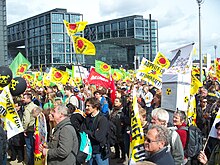Nuclear power? no thanks

The nuclear power logo ? No thanks , also called the anti-nuclear (power) sun , laughing or red sun , is the best-known logo of the anti-nuclear movement .
Emergence
The then 22-year-old economics student Anne Lund from Denmark had the idea in March 1975. After talking to Søren Lisberg, another activist, in April 1975 she drew the logo for the first time with an orange crayon with the original slogan “Atomkraft? Nej tak ”. The first 500 buttons with the logo found enthusiastic buyers during the May Day rally in Aarhus in 1975 . The goals at the time were
- to call on friendliness in the tense argument. The lettering does not make a request, but a question ("Atomkraft?"), Which it also answers politely ("No thanks"),
- to show an alternative to nuclear power ( solar energy ),
- Create a simple, recognizable image or logo.
distribution

As early as 1977, around a million copies of the buttons were sold in 16 countries. At that time the copyright was held by the Danish anti-nuclear organization Organizations til Oplysning om Atomkraft (OOA) in Copenhagen .
The logo is one of the most famous in the world. Since it was first published in small series, it has been translated into 45 languages and is now distributed millions of times. According to the OOA, the original designs have been on view in the Danish National Museum since 2000 . As an expression of contemporary history, pins can also be seen in the German Historical Museum .
A well-known, several meters high copy of the logo has been on Vestergade 7 building in Aarhus, Denmark ( 56 ° 9 ′ 27.2 ″ N , 10 ° 12 ′ 20.5 ″ E ) since 1975 , and is a popular postcard motif there.
The motif is registered with the EU harmonization office as community figurative mark no. 004193091 “NUCLEAR POWER? NO THANKS ”registered as a trademark. Environmental organizations that want to use the logo have to pay symbolic license fees to the Danish Foundation against Nuclear Power. The proceeds from this will be invested in projects of the anti-nuclear power movement.
Variations

In the case of print templates for stickers, protest flags, or buttons , the core of the logo was often adopted, but the details were changed. In addition to the font and language, this also affected individual aspects of the sun. One of the rays was designed as an outstretched arm with a clenched fist. In the original, the eyes of the sun are represented by simple curved arcs. In some later variants, black circles were added to give the face a direct look. Both gave the sun a more active expression. The clenched fist is reminiscent of the formal language of the labor movement .
other topics
There are also many different variations or parodies of the sticker on related political issues (e.g. " Genetic food ? No thanks!" With a laughing tomato), but also on completely different topics.
Web links
- Homepage of the OOA Fund ("The Smiling Sun" )
- Official EU trademark 004193091 (detailed trademark information )
- Image of the Vestergade 17 building in Aarhus from February 2009 on flickr
- Homepage of the OOA , viewed on January 15, 2011
- Hannes Gamillscheg: The woman with the smiling sun. In: Berliner Zeitung . October 23, 2010, accessed June 15, 2015 .
- Hannah Beitzer: Protest logo against nuclear power. The red sun laughs and laughs and laughs. In: Süddeutsche Zeitung . September 8, 2010, accessed June 15, 2015 .
- Broadcast by Zündfunks (Bayerischer Rundfunk) on December 28, 2010 ( brief description )
- Stuttgarter Zeitung from March 25, 2011
Individual evidence
- ↑ cf. Jochen Antz: Solar energy - she was a student, sat in her room and painted a small picture. So the Danish Anna Lund invented the symbol of the anti-nuclear power movement 36 years ago , Süddeutsche Zeitung No. 65, p. 3, 19./20. March 2011.
- ^ Atomic protest with strong turnover . In: Der Spiegel . No. 36 , 1977 ( online - Aug. 29, 1977 ).
- ↑ "Nuclear Power - No Thanks" Logo. In: brand magazine: right. October 2, 2010, accessed March 23, 2011 .
- ↑ cf. Jochen Antz: Solar energy - she was a student, sat in her room and painted a small picture. So the Danish Anna Lund invented the symbol of the anti-nuclear power movement 36 years ago , Süddeutsche Zeitung No. 65, p. 3, 19./20. March 2011.
